Commissioning Information>> Gold Information

Gold, Sterling Silver & Hallmarking Information
Sustainable Precious Metals
The allure of precious metals has continued throughout the centuries. For thousands of years these metals have been crafted into jewellery using tools and techniques, many of which are still in use.
Using sustainable materials is important to be me. Rather than purchasing newly mined materials to create my designs I source precious metals from bullion dealers and refiners that use recycled precious metals. I work in a number of different precious metals including 9ct and 18ct yellow, white and red / rose gold and Sterling Silver. Please find some information below which goes into more detail about precious metals, their properties and qualities.
An Introduction to Gold Alloys - Durability, Appearance & Cost
Pure (24ct) gold is too soft to be practical for jewellery so it is mixed with other metals to make it durable. Other metals such as silver and copper are combined with gold to make it suitable to wear. The type and ratio of other metals used alters the characteristics, appearance and properties of the alloy. There are many differences between the carats and colours of gold, not just their gold content but the general look, finish, colour, weight and tarnish resistance.
In short, the alloy I recommend is 18ct gold. It's optimum mix of a minimum of 75% gold (double that of 9ct gold) and other metals offers both quality in appearance and finish, resilience to wear and excellent resistance to tarnish and corrosion. For these reasons I recommend this alloy especially for items such as wedding and engagement rings which need to withstand the rigours of everyday wear for a long period of time.
Choosing a Carat of Gold
If the budget allows I always recommend 18ct gold. For a lower price point 9ct gold is something to consider, but it is important to know the differences between the carats and colours of gold. This is not just the gold content but resistance to wear, general look, finish, colour, weight and tarnish resistance. Further details about the carats of gold, their colours and general properties can be found below.
Durability
9ct and 18ct gold are created by alloying gold with other metals. The addition of copper acts to harden gold, especially when used in conjunction with silver. It is possible to create both hard and soft alloys of 9ct and 18ct gold. However, in general most common 18ct gold alloys are both harder, and harder wearing than their 9ct equivalent. 9ct hard alloys tend to be slightly brittle, whereas 18ct gold alloys are more ductile and resilient.
There is a common misconception that 9ct gold is harder or more hard wearing than 18ct gold. In fact, it is possible to make both hard and soft alloys of these carats. Adding the type and ratio of other metals to alloys alters it's look and properties. Even still, when both alloys are measured on the Victors scale of hardness, 18ct gold alloys are generally harder than 9ct gold alloys. In fact, with 9ct's lower gold content and higher proportion of other metals such as silver and copper this alloy is more brittle than 18ct gold. It is also harder to work, and does not 'give' as easily as 18ct gold which is much more ductile. For instance if reworking 9ct gold it is much more likely to crack than 18ct gold.
18ct gold alloys have a great durability and are more able to withstand the knocks of everyday wear compared to 9ct gold. A key difference between the two alloys is it's appearance. Not only do higher carats have a higher resistance to tarnish, chemicals and corrosion, but 18ct gold also has a far superior colour and finish to that of 9ct gold. Therefore on balance 18ct gold provides the best all round properties in both durability and appearance.
It is possible the misconception that 9ct gold is harder than 18ct has arisen from the fact that most people know 24ct gold is very soft and not ideally suited to jewellery. It is also widely known that 22ct is quite soft as it only has a small amount of other metals added to it (I generally only work with this if the customer wants their own gold worked into a design for sentimental reasons). Given that logic it is possible to see why the myth has perpetuated that the more gold an alloy contains, the softer it is. However, I hope that this information has helped to give you an overview of why I recommend 18ct gold.
Tarnish Resistance
Pure gold does not corrode. The higher the gold content the greater the resistance to corrosion and tarnish. With a 75% gold content 18ct alloys are almost completely resistant to tarnish, whereas 9ct alloys are less so. This is because 9ct gold is alloyed with higher quantities of base metal (such as copper). Base metals are susceptible to oxidisation (tarnishing) from chemicals in the atmosphere as well as perspiration, perfume, some fabrics and household chemicals etc. This means that like sterling silver, lower carat alloys such as 9ct and 14ct gold are susceptible to discolouration (tarnish). These alloys require regular cleaning to maintain their appearance or to remove tarnish but some areas may be harder to clean by hand. I supply a polishing cloth impregnated with anti-tarnishing properties which can help to keep your jewellery clean but please see the 'Jewellery Care' page for further details.
Carats of Gold:
In order to be durable for wear, gold needs to be alloyed (mixed) with other metals such as silver, copper, zinc or palladium in the case of white gold. The ratio of the alloys used determines its properties, colour and carat i.e. 9ct, 14ct, 18ct & 22ct gold. The carat of gold refers it's purity (the minimum amount of gold in the alloy) where pure gold is expressed in parts per thousand. For instance 18ct gold items are hallmarked '750' to indicate that no less than 750 parts per 1000 is pure gold, meaning that the other 25% is made up of other metals. 24ct gold is 100% pure gold and as such is too soft to be practical for use in jewellery. This is why gold needs to be alloyed with other metals to make it durable for wear.
22ct Gold

22ct gold generally has a lovely rich yellow hue. It is possible to make different mixes so some may appear more of a rose colour than others. This was a very popular carat in the past but with it's gold content at no less than 91.6% it is still quite soft. It's not a carat I generally work with, the exception being when using an old piece of jewellery within a new design for sentimental reasons. To replicate the look, a practical alternative to 22ct gold is 18ct rose gold as it has a very similar look but is more suited to withstand everyday wear, particularly when is used in rings.
18ct Gold
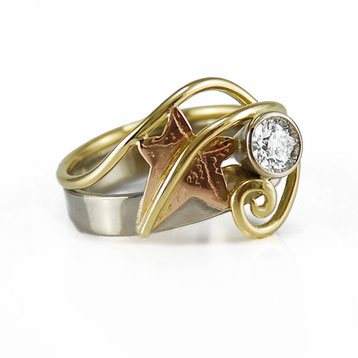
With a minimum gold content of 75% (whether yellow, white and red colours) 18ct gold has the optimal ratio of gold to other metals which gives it the best all round properties for everyday wear. It is more ductile than it's 9ct counterpart which is more brittle. With 18ct offering the best balance between quality and resilience, it makes it the preferred choice for fine jewellery.
It's properties make it is particularly suitable for creating wedding and engagement rings which are intended to be worn for an extended length of time. It will also withstand the rigours of everyday wear better than 9ct gold. I work in three colours of 18ct gold - yellow, white and red/rose, which work well on their own or in combination with one another.
18ct Gold items are hallmarked 750 to indicate that its gold content is a minimum of 75%. The higher the carat, the more gold the alloy contains, the heavier the metal and greater its resistance to oxidisation (tarnish) and corrosion.
9ct Gold

9ct gold is available in yellow, white and red colours which are a paler hue than that of 18ct gold. It is the most commonly used carat of gold in the UK but not really used in other countries. It's content is made up of just over a third of gold with the other metals being silver and copper. 9ct gold is hallmarked '375' to indicate its minimum gold content of 37.5%. Due to the higher proportion of other metals in this alloy, it is more susceptible to oxidisation (tarnishing) from chemicals in the atmosphere as well as perspiration, perfume, some fabrics and household chemicals etc. It is also more brittle and less hard wearing compared to that of 18ct gold due to it's lower gold content and high proportion of other metals. Further details of which can be found below.
14ct Gold
14ct Yellow Gold is somewhere in between 9ct and 18ct. Although sometimes it's possible to consider working in this metal, it is not something which is widely used in the UK and is more common in used in the USA. Like 9ct gold for the same reasons as above, it is still susceptible to tarnish.
Colours of Gold:
Gold alloys can be created to a number of different colours. The most common being yellow, red and white. The colour of a precious metal is achieved by changing the type and ratio of
other metals used when it is alloyed. For example, a higher proportion of palladium (a member of the platinum family) is alloyed to the gold to achieve 'white' gold and similarly, a higher
proportion of copper is added to create red/rose gold.
Using two or more colours of gold can add contrast and enhance a design. You will find a number of examples of this in the 'Bespoke Gallery'.
Yellow Gold
Yellow gold alloys are created by alloying gold with silver and copper to make it durable for wear.

18ct Yellow Gold is rich, bold and bright with a beautiful lustre. This is due to it's high gold content (no less than 75%), which also makes is highly resistant to tarnish. This optimum ratio of gold to other metals is why I recommend it. This alloy offers both quality and resilience which means it is ideally suited for wedding and engagement rings and is wonderful on it's own or used to highlight elements of a design.

9ct Yellow Gold is a more subtle yellow hue, lighter than it's 18ct gold counterpart. With a lower gold content of 37.5% it is a mellow yellow but with a higher amount of base metal this alloy it is susceptible to tarnish and wear. It is also brittle compared to 18ct gold.
14ct Yellow Gold is somewhere in between in colour although not widely used in the UK, this alloy is more commonly used in the USA.
Red & Rose Gold
Red / Rose gold is created by alloying gold with a higher proportion of copper than other alloys.
18ct Red Gold
Like all 18ct alloys, 18ct red gold has a minimum of 75% gold. It owes it colour to the higher proportion of copper content in the other 25% of the alloy and has a rich warm hue. 18ct red gold looks especially stunning when used in contrast with 18ct white gold. When used in combination with yellow gold the difference it much more subtle but can add a rich warm colour to a design. I often use 18ct red gold for leaves as it gives a wonderful autumnal feel to a piece.
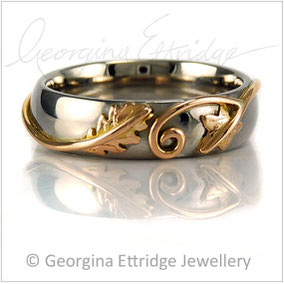
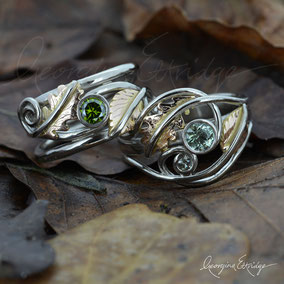
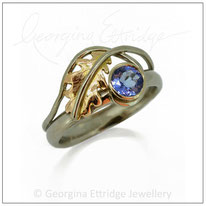
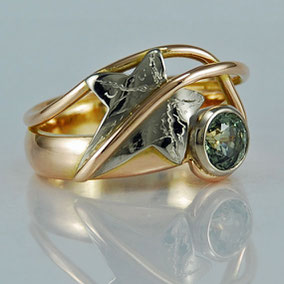
9ct Red Gold
This alloy is a stronger red colour than 18ct gold because of it's high copper content. When used in combination with 9ct white gold the contrast is quite strong, but is much more subtle when used alongside 9ct yellow gold (the oak ring on the left is an example of this).
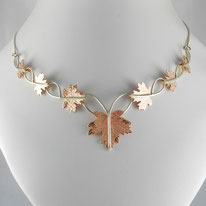
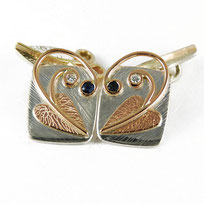
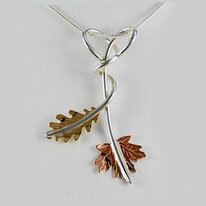
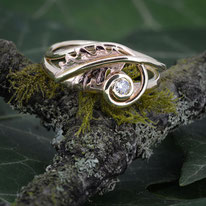
White Gold
White gold is created by alloying yellow gold with 'white' metals to achieve a 'whiter' appearance.

18ct White Gold is created by alloying yellow gold with other 'white metals'
I use a high palladium content 18ct white gold alloy. Palladium is a member of the platinum family and when alloyed with gold makes an alloy which has a lovely warm tone and a subtle grey colour. For reference, palladium is a member of the platinum family. Using a high palladium content alloy means that pieces made from this do not require rhodium plating (info below) which is standard practice for commercial jewellery where lower quality alloys are generally used which have a brown yellow appearance.
I generally don't recommend plating as it wears over time and gives an uneven appearance. It can look patchy and discoloured if the rhodium plating wears off revealing the commercial 'browner' 18ct white gold alloy underneath which almost looks like tarnish. There are further details about this below.
You may of course already own a ring (such as an engagement ring) that has been plated so it's understandable why you may want to consider rhodium plating any ring worn with it. However both plated and high palladium alloys can work well together. Rhodium plating is an option but I would always recommend people seeing the piece in it's natural state before deciding.

9ct White Gold is similar to silver but has a slightly yellow tinge. This alloy contains a minimum of 37.5% gold with the rest made up of copper, silver and zinc to 'whiten' the alloy. However, like other 9ct alloys it contains copper which makes the alloy susceptible to discolouration (see 'tarnish resistance' above). It is also brittle and less resilient to wear than 18ct gold.
Rhodium Plating
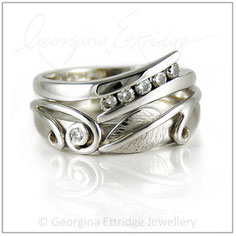
Rhodium (a white metal which is a member of the platinum family) is commonly used to plate most commercially produced 18ct white gold to achieve a 'whiter' finish on greyer or browner 18ct white alloys. It's finish is nearly as white as silver but with a slightly cooler look. Rhodium is a hard wearing metal but with time (especially with rings) the finish will wear and require re-plating, which is far from ideal. The length of time in which this will need to be carried out is hard to predict and will vary from wearer to wearer.
Combining Colours of Gold
A great way to enhance elements of the design is to create it in different colours of gold. The combination in which they are used also has a bearing on the appearance. For example when red gold is used to highlight details such as leaves and tendrils on a white gold band their is a striking contrast, but when yellow and red gold are used together on the same piece the difference can be more subtle. It works particularly well when leaves are in red gold as it bring a warmth and autumnal feel to the piece.
Below are some examples of designs created in both 18ct and 9ct alloys in various colours combinations of gold. 9ct gold colours have a lighter hue so the contrast isn't as great as when using 18ct gold.
Here are a couple of examples of designs created in both 18ct and 9ct alloys in various colours and combinations of gold.
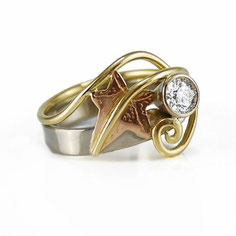

Mixed Metals

Sterling Silver & Gold
Combining sterling silver and gold can be a great way to highlight the details of a piece, although due to it's relative softness to gold I don't recommend sterling silver for wedding rings.
Sterling Silver (925)
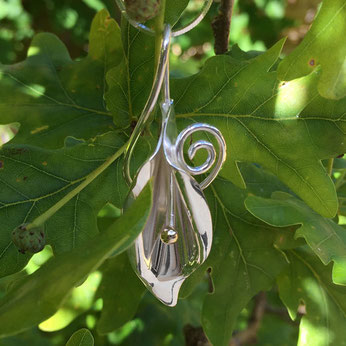
Sterling Silver is a worldwide recognised form of precious metal. The fineness of the precious metal content of jewellery and silverware is expressed in parts per thousand. Sterling Silver items are hallmarked 925 to indicate it contains 92.5% silver. It is inadvisable to create jewellery from pure silver as it is too soft and therefore alloyed (mixed) with copper to make it durable. Please see the 'Jewellery Care' page for further information about how to look after your jewellery.
Due to it's relative softness and quicker rate of wear than other precious metals, I would not recommend creating items such as wedding and engagement rings in sterling silver. This is true of rings with fine detail. Gold is much more suited and has a greater durability to withstand the rigours of everyday wear for a long period of time.
Hallmarks

In the U.K precious metals are hallmarked. A hallmark is an independent worldwide respected guarantee of the fineness and quality of precious metal. It comprises a series of marks applied to articles of gold, silver and platinum. It indicates the piece has been independently tested at an Assay Office and guarantees that it conforms to the legal standards of precious metal content known as fineness.

My Sponser's Mark 'GE' is struck on all pieces and is registered at The Goldsmiths' Company, Assay Office, London, which has a record of testing the quality of gold and silver dating back to c1300. A Sponsor's mark takes the form of the makers initials surrounded by a shield design and is unique to the maker.
A Hallmark consists of a series of marks applied to articles of precious metals including, platinum, gold, palladium and silver.
- Who made the article - The Sponsor's mark - the initials of the maker (GE)
- What the metal is - The Traditional Fineness mark (example; gold is signified by a crown) & the Millesimal mark which signifies the metals fineness/purity (example; 750 - for 18ct Gold).
- Where it was tested (Assayed) and marked - the Assay Office mark. (London - Leopard's Head Mark).
- When the piece was stamped - The date letter signifies this (example; 'r' for 2016).

The majority of my work is hallmarked, with the exception of some smaller items such as silver items that weigh under 7.8 grams or pieces under 1 gram in gold, which is the maximum legal limit for un-hallmarked pieces and/or pieces that are exempt because hallmarking would damage the design. However, quite often pieces that are under this weight are hallmarked anyway. If you have any questions to whether a piece is hallmarked, please contact me.

For further information please see the Hallmark Notice page or visit www.thegoldsmiths.co.uk
You may also find some of the other
'Commissioning Information' pages of interest including 'Commissioning Process', 'Sizing Information', 'Precious Metal & Hallmarks', 'Gemstone Information', 'Heirloom Redesign' and 'Enquiry Forms'.
I hope these have been of help and I look forward to discussing your commission.
For inspiration please also visit the 'Bespoke Gallery' pages.
